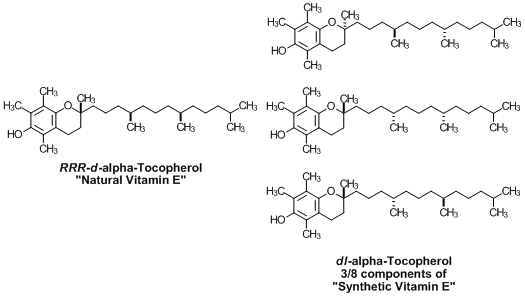Why Natural Vitamin E is more than worth the added cost
You might think that natural vitamin E and synthetic vitamin E have to be pretty much the same thing if you can buy either one at your drug store. The reality of the situation, however, is much more complicated. This article describes why you only want to be taking natural vitamin E.
Most of the time when a complex molecule from nature is made and put in a pill form, it is completely identical. Often synthetic materials are even more pure than natural extracts, and this can have advantages. But vitamin E is actually quite a bit different.
Synthetic vitamin E is a complicated stereoisomeric mixture that contains the "natural" form of alpha tocopherol along with 7 other related isomers. You can usually tell that you are getting synthetic material because it is described on the label as "dl-alpha tocopherol". The "dl" means that it is mixture of different stereoisomers, compounds that have the same connectivity, but exist as mirror images of one another.
As you can see from the structures below, there are three positions on the vitamin E molecule which can be varied to produce a stereoisomeric mixture. When nature makes vitamin E, it makes only the RRR form. But this material is difficult to extract, so a cheaper synthetic form was created. There is, however, a catch-- the synthetic form is a random mixture of stereoisomers.

Why is this unusual chemistry issue important? Well, to start off, the law is completely inadequate when it comes to vitamins and drugs. When you have two different stereoisomers of a drug, they are actually considered two different drugs, as they can have wildly different effects (see the thalidomide tragedy for an example). But when you have RRR-tocopherol in a synthetic mixture with 7 different stereoisomers, suddenly we have a different formulation of the same drug.
The reality is that the body preferentially recognizes and absorbs the natural RRR form, and excretes the other forms in the urine. So at the first level of understanding, you are peeing away your money when you take synthetic vitamin E (1).
But there is actually a much deeper level of complexity here. The different isomeric forms of tocopherol can actually prevent retention of natural vitamin E in some tissue types. And moreover, having synthetic vitamin E in your system can even accelerate the elimination of the RRR form by upregulating CYP and P-gp enzymes in your liver. The effects vary widely between tissue and cell types and greatly complicate the pharmacology of vitamin E (2). For instance, the all-rac, or synthetic, form of vitamin E is known to cause contact dermatitis, while the natural version does not.
The bottom line here is that synthetic tocopherol not only gives you a less effective dose of vitamin E, it also may be interfering with your body's capacity to manage the proper form of the vitamin, natural vitamin E.
Click here for more on the health benefits of natural vitamin E
![]()
References:
1. Traber, MG, Elsner, A, Brigelius-Flohe, R. "Synthetic as compared with natural vitamin E is preferentially excerted as alpha-CEHC in human urine: studies using deuterated alpha-tocopheryl acetates." FEBS Lett. 437 (1998) 145-8.
2. Blatt, DH, Pryor, WA, Mata, JE, Rodriguez-Proteau, R. "Re-evaluation of the relative potency of synthetic and natural alpha-tocopherol: experimental and clinical observations." J Nutr Biochem. 15 (2004) 380-95.


